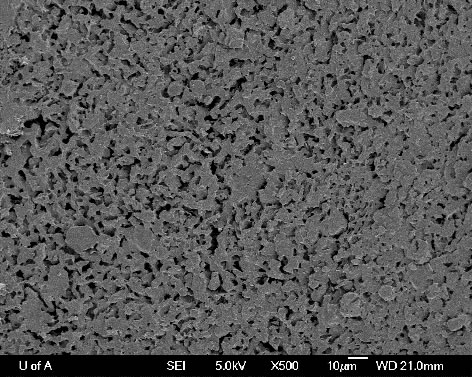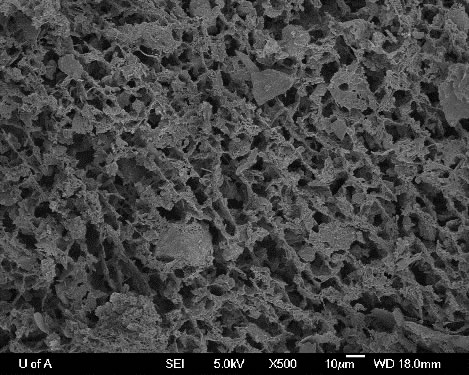Dewatering Wet Tailings Generated From Oil Sands Extraction
Lead Proponent: University of Alberta
Location: Edmonton, AB
ecoEII Contribution: $ 859,000
Project Total: $ 2.17 M
Project Background

Cryo-SEM (scanning electron microscopy) image of mature fine tailings
Bitumen extraction from surface minable Alberta oil sands using the Clark Hot Water Extraction Process (CHWE) consumes significant amounts of fresh water and generates large amounts of unconsolidated wet tailings. On average, to produce one barrel of bitumen, 4-6 barrels of fresh water are required, and 12-15 barrels of tailings wastes are generated. While the majority of the tailings settle quickly allowing much of the contained process water to be recycled, about 1.6 barrels of the tailings form Mature Fine Tailings (MFT), which consist of residual bitumen, fine clays and water, take years to settle, and trap some of the process water, which cannot be recycled. To date, oil sands production has accumulated 650 million cubic meters of MFT that are impounded in 176 km2 of tailings ponds.
Amendment of the tailings slurry by polymer flocculants (chemical means) followed by mechanical solid-liquid separation methods (physical means) is potentially the only way to remediate the oil sands tailings problem. Numerous studies have been conducted to speed up dewatering (water release from MFT) and consolidation of tailings. However, knowledge and technology gaps associated with slow dewatering and consolidation of oil sands tailings still exist. Recognizing the need, the Institute for Oil Sands Innovation (IOSI) at the University of Alberta proposed the project “Dewatering Wet Tailings Generated from Oil Sands Extraction” for ecoEII funding and was awarded $952K to address the challenge of volume reduction of wet tailings generated from current commercial hot‐water extraction processes.
Results

Cryo-SEM image of mature fine tailings treated by dual polymer flocculants, showing more porous structure
Text version
Treating the oil sands tailings generated large pores in the oil sands tailings, which benefit water removal from the tailings.
The Project was divided into six phases which, when combined, represented a holistic approach to the fundamental aspects of flocculation and dewatering of tailings. Eight principal investigators and thirty post-doctoral and graduate student researchers from the universities of Alberta, British Columbia, and Montreal, as well as the Technical University of Delft implemented the multi-phase Project. Activities included: modeling and computer simulation of the mixing and aggregation of fine particles in dense solid-liquid slurry in the presence of polymer flocculants; design and synthesis of novel amphiphilic polymer flocculants; use of existing commercial polymers (of different molecular weights and ionic characters) in two stage sequential treatment of the tailings; study of depositional behaviors of the polymer-flocculated tailings, and the effect of vacuum or pressure filtration; and, investigation of the polymer-mineral interaction mechanisms using sum frequency generation vibrational spectroscopy.
Results showed that the use of amphiphilic polymers with both hydrophilic and hydrophobic components improved dewatering performance over and above the use of hydrophilic polymer flocculants only. Two-stage sequential addition of the polymers, especially high molecular weight anionic polyacrylamide followed by high molecular weight non‐ionic polyethylene oxide, demonstrated much better dewatering then when either polymer was used alone. Filter press pressure filtration of mature fine tailings treated by the two-stage polymers could generate filter cakes that contained more than 60 weight percent (wt%) solids, exceeding the solid content of other techniques reported so far.
Benefits to Canada
The volume of the MFT in Alberta is a major environmental liability for Canada, posing risks to wildlife, ecosystems and humans. A decrease in the volume of MFT would help mitigate the ecological and human impact of bitumen extraction in Alberta’s oil sands and improve Canada’s technological competitiveness in the global market.
Next Steps
The proper reclamation of the oil sands tailings requires that tailings be dewatered to greater than 75 wt% solids. Therefore, the results of this project are promising but not there yet. More R&D is needed and should focus on identifying the detrimental roles of residual bitumen in the oil sands tailings on dewatering, and identifying the remediation measures to overcome these detrimental effects.
Page details
- Date modified: